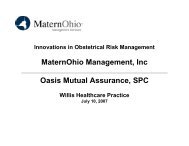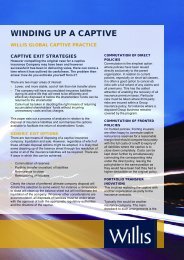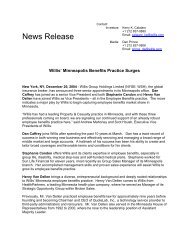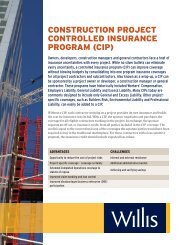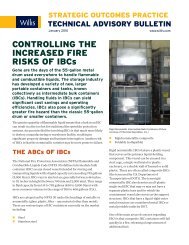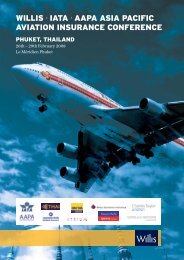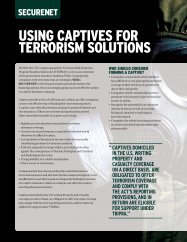Env Spring Newsletter.qxd - Willis
Env Spring Newsletter.qxd - Willis
Env Spring Newsletter.qxd - Willis
Create successful ePaper yourself
Turn your PDF publications into a flip-book with our unique Google optimized e-Paper software.
<strong>Env</strong>ironmental Risk<br />
January 2006 – Issue 7<br />
New <strong>Env</strong>ironmental<br />
Disclosure Obligations<br />
and Market Solutions<br />
By Michael Balmer and Jim Redwine<br />
Public companies’ accrual and disclosure<br />
practices for their environmental<br />
liabilities have long been perceived as<br />
inconsistent and in some cases<br />
inadequate. Recent developments such<br />
as FIN 47 have tightened the disclosure<br />
rules, especially in relation to<br />
environmental liabilities. While the recent<br />
changes follow a long line of accounting<br />
pronouncements (including SAB 92, SOP<br />
96-1, and FAS 143) designed to<br />
standardize the reporting of<br />
environmental liabilities, they also raise<br />
many questions and pose a host of new<br />
challenges for senior management.<br />
Background<br />
<strong>Env</strong>ironmental liabilities are among the<br />
significant issues that impact investment<br />
decisions. The SEC therefore requires<br />
public companies to recognize and/or<br />
disclose both current and contingent<br />
environmental liabilities in their annual<br />
10-K filings. However, only those<br />
liabilities that are considered material are<br />
required to be disclosed, and longstanding<br />
Financial Accounting Standards<br />
Board (FASB) rules such as FAS 5 dictate<br />
that a loss contingency should be<br />
accrued if it is probable that it will occur<br />
and the amount of the loss can be<br />
reasonably estimated.<br />
The inherent flexibility of these rules has<br />
allowed companies to interpret their<br />
disclosure obligations in different ways.<br />
This problem is epitomized by how some<br />
companies account for potentially<br />
contaminated, non-performing real<br />
estate assets. Reluctant to initiate<br />
investigations that might trigger<br />
enforcement actions and remediation<br />
expenditure, some companies have<br />
adopted a so-called “don’t ask/don’t<br />
tell” policy which involves mothballing<br />
potentially contaminated facilities and<br />
thereby not reporting future remediation<br />
obligations.<br />
Recent Developments<br />
The Sarbanes-Oxley Act of 2002 (SOX)<br />
does not specifically address<br />
environmental disclosure, but it has<br />
changed the legal and political context in<br />
which such disclosure requirements must<br />
be interpreted. SOX is specifically<br />
designed to ensure that companies look<br />
beyond mere compliance with GAAP<br />
requirements when preparing their<br />
financial statements and that CEOs and<br />
CFOs personally certify the disclosures<br />
made by their organizations.<br />
Further developments in the past 12<br />
months have raised the bar even higher<br />
and may combine to change the way<br />
corporations report environmental<br />
liabilities. Significant changes include<br />
new 8-K disclosure requirements which<br />
mean that certain environmental<br />
liabilities, such as a determination that<br />
one of the company’s assets is<br />
contaminated, will now compel<br />
companies to file an 8K, and, the new<br />
Contents:<br />
New <strong>Env</strong>ironmental<br />
Disclosure Obligations<br />
and Market Solutions page 1<br />
Life After BRAC 2005 page 3<br />
Hot Issue Update page 6<br />
Events page 4<br />
New Faces page 5<br />
Key Contacts page 8<br />
...developments in the past<br />
12 months have raised the<br />
bar even higher and may<br />
combine [with the effects of<br />
Sarbanes Oxley] to change<br />
the way corporations report<br />
environmental liabilities<br />
1 <strong>Willis</strong> North America • 01/06
FASB interpretation on “Accounting for Conditional Asset<br />
Retirement Obligations”, FIN 47, which will require companies<br />
to recognize and report an environmental liability even if the<br />
enforcement of the liability is conditional upon future events that<br />
are not within the control of the reporting company. These<br />
developments may well close the “don’t ask/don’t tell” loophole<br />
and prevent companies from deferring the reporting of liabilities<br />
by mothballing sites.<br />
FIN47<br />
FIN 47, issued in March 2005, addresses Conditional Asset<br />
Retirement Obligations (CAROs). CAROs are legal obligations to<br />
perform asset retirement activities in which the timing and/or<br />
method of settlement are conditional on future events that may<br />
or may not be within the control of the entity. <strong>Env</strong>ironmental<br />
cleanup and disposal obligations in connection with the<br />
retirement of contaminated property, plant and equipment are<br />
CAROs. Retirement is defined broadly by FIN 47 to include not<br />
only demolition of a non-performing asset, but also includes the<br />
sale, abandonment, recycling or disposal (but not temporary<br />
idling) of a long-lived asset.<br />
The regulatory obligation to remove asbestos on the renovation<br />
or demolition of a building is a CARO. The environmental<br />
regulation is in force today, but the asbestos will not be removed<br />
until the owner decides in the future to retire the building. Since<br />
retirement is defined to include sale and recycling, the building<br />
(or parts of it) may be retired a number of times before it is finally<br />
demolished. Thus, the cost of the asbestos removal may be<br />
incurred long before the end of the building’s useful life (as when<br />
the price is reduced on a sale because of the asbestos<br />
contamination).<br />
FIN 47 clarifies that companies must recognize liabilities for<br />
CAROs if their fair value can be reasonably estimated, and<br />
provides guidance for the estimation of fair value.<br />
FIN 47 establishes an order of methods to determine whether<br />
the fair value of a CARO can be reasonably estimated. According<br />
to FIN 47, a CARO’s fair value can be reasonably estimated if:<br />
(1) The fair value of the obligation is embodied in the purchase<br />
price of the asset, such as if insurance or an escrow is provided<br />
for the obligation.<br />
(2) There is an active market for the transfer of the obligation (as is<br />
provided by insured environmental liability transfer transactions).<br />
(3) There is enough information to apply an expected present<br />
value technique.<br />
If there is not enough information to estimate the fair value of<br />
the obligation, the company does not have to recognize a<br />
liability. However, the company must make certain special<br />
disclosures. In these circumstances, companies are required to<br />
describe the obligation, state that a liability has not been<br />
recognized because the fair value cannot be reasonably<br />
estimated, and disclose why the value cannot be reasonably<br />
estimated. And, as far as FIN 47 goes, SOX’s certification<br />
requirements seem to require more, because the certification<br />
that financial statements fairly present the financial condition of<br />
the company are not limited to GAAP.<br />
Incentives and Market Solutions<br />
In the era of corporate transparency and heightened investor<br />
scrutiny, proactivity is imperative. <strong>Env</strong>ironmental risk management<br />
should include re-evaluation of the adequacy of existing internal<br />
control and disclosure control policies, including establishment of<br />
appropriate systems for ensuring accurate data collection and<br />
consistent evaluation of environmental liabilities, and thorough<br />
assessment of available risk management tools. FIN 47 should add<br />
impetus to this process, because FIN 47 requires companies to<br />
“identify all [their] conditional asset retirement obligations.”<br />
Once an environmental liability has been identified and<br />
determined to be “material,” there are several mechanisms<br />
2 <strong>Willis</strong> North America • 01/06
available to mitigate the exposure and demonstrate that it is<br />
thoroughly and adequately managed. These options might<br />
include accelerated clean up of a contaminated site, sale of<br />
relevant sites or operations, and/or use of risk transfer<br />
arrangements such as environmental insurance or liability<br />
transfer alternatives. Indeed, two of the three methods FIN 47<br />
mentions for estimating the fair value of a CARO (when the fair<br />
value is embodied in the price of an asset through the use of<br />
insurance or when there is an active market for the obligation’s<br />
transfer), seem to provide significant incentives for insured<br />
Brownfield and environmental liability transfer transactions.<br />
Michael Balmer is Senior Vice President of <strong>Willis</strong> North America’s<br />
national environmental practice. He can be reached at<br />
michael.balmer@willis.com<br />
James M. Redwine, J.D., an environmental and corporate lawyer,<br />
is Senior Vice President of Shaw <strong>Env</strong>ironmental Liability<br />
Solutions, LLC, a company that specializes in providing markets<br />
for the transfer of environmental liabilities. He can be reached at<br />
jim.redwine@shawgrp.com.<br />
Life After BRAC 2005<br />
Background<br />
The Department of Defense (DOD) has excess land capacity for<br />
its current requirements. As a consequence, it has been<br />
progressively realigning and closing military installations in a<br />
rolling initiative known as the Base Realignment and Closure<br />
(BRAC) program. There have been four previous BRAC rounds,<br />
but BRAC 2005 is considerably larger than previous rounds, and<br />
it is the first one in a decade.<br />
The BRAC 2005 round includes the closure of 22 major military bases<br />
and the realignment of another 31 major bases. In total, however,<br />
BRAC 2005 will involve the closure of over 175 military installations.<br />
The final list took effect on November 8, 2005 after Congress<br />
passed the BRAC Commission’s recommendations into law.<br />
Nearly every state has a base that will be shut down. Those<br />
communities affected by base closures and/or realignments are<br />
charged with facilitating the beneficial re-use and<br />
redevelopment of these facilities.<br />
Going Forward<br />
Each individual privatization project presents many challenges,<br />
including the management of environmental liabilities and the<br />
successful coordination of development time pressures with the<br />
slow moving federal conveyance process. <strong>Env</strong>ironmental insurance<br />
has played a key role in facilitating BRAC development projects.<br />
An example of a high profile success story is the redevelopment<br />
of the 1,800-acre Lowery Air Force Base near Denver. Since<br />
1994, residential and commercial redevelopment has provided<br />
3,000 homes for 6,500 new residents while creating<br />
approximately 6,000 jobs and yielding around four billion dollars<br />
for the Denver metropolitan area.<br />
While the closing and realignment of military bases is generally<br />
viewed by local residents as a potentially catastrophic<br />
development for their community, the judicious use of<br />
environmental insurance can frequently enhance the speed and<br />
ease the pain of the transition, helping to turn a devastating<br />
event into new life for the area.<br />
More information on the BRAC process will follow in future<br />
editions of this newsletter.<br />
Each individual privatization project<br />
presents many challenges, including the<br />
management of environmental liabilities<br />
and the successful coordination of<br />
development time pressures with the slow<br />
moving federal conveyance process.<br />
Hot Issue Update: Welding Rod<br />
Exposures<br />
Fumes from welding rods constitute the latest hot button toxic<br />
tort issue. Such fumes are the cause of much current and<br />
ongoing litigation involving welders who claim to have been<br />
injured by exposure to the fumes, and companies who<br />
manufacture welding and associated equipment, including<br />
welding rods. Many of our clients have started to see an impact<br />
on coverage and, as a result, have sought information about<br />
exposures in this emerging tort area. This article will help frame<br />
the issue.<br />
Framing the Health Issues<br />
Welding rods typically consist of metal coated with or containing<br />
zinc, lead, chromium, cadmium, copper, manganese, and other<br />
chemicals and metals. Manganese, one of the most common<br />
elements found in the earth’s crust, is also one of the most<br />
commonly used metals in the world. Unfortunately, exposure to<br />
excessive levels of manganese can cause damage to the central<br />
nervous system and has been associated with a neurological<br />
disorder call manganism. Symptoms of manganism often<br />
3 <strong>Willis</strong> North America • 01/06
esemble those of Parkinson’s disease and can include muscle<br />
stiffness and soreness, night sweats, hand shakes/tremors, loss<br />
of coordination, memory loss and fatigue. Other illnesses<br />
associated with long-term exposure to welding rod fumes<br />
include kidney and liver damage, respiratory disease, lung cancer<br />
and weight loss.<br />
Framing the Potential Liability<br />
Welding is a ubiquitous industrial operation employed in a<br />
multitude of endeavors from building ships, bridges and buildings<br />
to the manufacture of electronics, plastics and heavy equipment.<br />
To the hundreds of thousands of active welders must be added<br />
perhaps half as many retired workers, as well as the far larger<br />
number of workers who are likely exposed to welding fumes in<br />
the workplace. This makes for a large potential plaintiff’s pool<br />
and, as a result, dozens of law firms now pursue class action<br />
lawsuits against companies who manufactured or distributed<br />
welding rods and/or supplied other materials (including gasses)<br />
needed to support the welding operation. Target defendants also<br />
include several industry groups, and estimates for costs could<br />
easily reach many billions of dollars.<br />
Recent Legal Impact<br />
Insurers that currently provide (or have provided) comprehensive<br />
general liability coverage to welding rod manufacturers,<br />
distributors, retailers and others whose main business activity is<br />
centered around welding, will likely incur defense expenses and<br />
maybe even indemnity payments depending on coverage and<br />
whether or not the lawsuits prove successful. Defense attorneys<br />
have argued that because no causal link has been established<br />
between exposure to welding fumes and the most serious<br />
neurological disorder, those cases involving high potential<br />
damage claims from Parkinson’s should not be allowed.<br />
However, in federal court in Cleveland in July, 2005, US District<br />
Judge Kathleen McDonald O’Malley denied a defense motion to<br />
exclude testimony that welding fume exposure causes a serious<br />
neurological disorder. While this move does not address the<br />
question of whether or not welding fumes cause Parkinson’s, it<br />
will likely help shape a mass of litigation now poised to move<br />
forward in federal and state courts around the country.<br />
Welding is a ubiquitous industrial operation<br />
employed in a multitude of endeavors from<br />
building ships, bridges and buildings to the<br />
manufacture of electronics, plastics and<br />
heavy equipment.<br />
Conclusion: Impact on Insurance<br />
Until now, there has been an ongoing debate as to whether or<br />
not the insured who bought a comprehensive general liability<br />
policy is entitled to indemnity payments for successful claims<br />
brought against them in this area. Since 1986, claims for injuries<br />
caused by hazardous fumes have been specifically excluded by<br />
the absolute pollution exclusion which was attached to such<br />
policies. Some jurisdictions, however, have found that the<br />
exclusion does not apply to non-traditional and nonenvironmental<br />
claims or, in other words, if the claim arises out of<br />
ordinary workplace exposure to ordinary substances, which in<br />
sustained exposure, caused the damage. As a result, many<br />
insurance companies now avoid entities primarily engaged in<br />
welding operations or the manufacture of welding and related<br />
equipment. Others have started putting welding rod exclusions<br />
on their policies to avoid the potential for litigation.<br />
For more information, please contact Gary Rodrigues at 617 351<br />
7405 or gary.rodrigues@willis.com.<br />
Events<br />
<strong>Willis</strong> made a big splash at the annual <strong>Env</strong>ironmental<br />
Financial Consulting Group (EFCG) CEO Conference held in<br />
New York City in October. We served as one of six primary<br />
sponsors (the sole sponsor from the insurance brokerage<br />
community) at this exclusive event whose attendees included<br />
more than 250 chief executives from leading engineering and<br />
consulting companies, including Bechtel, CH2MHill, CDM, SAIC,<br />
Tetra-Tech, Weston, AECOM, Amec, Black & Veatch and Fluor.<br />
Paul Becker, President of the <strong>Willis</strong> Construction Practice,<br />
joined John Reynolds,<strong>Willis</strong> <strong>Env</strong>ironmental Practice leader, and<br />
Gary Rodrigues, Mike Balmer and Rick Secchia of the<br />
<strong>Env</strong>ironmental team at the event's opening reception at the New<br />
York Yacht Club. Paul later presented "Current Insurance<br />
Realities Facing E&C Firms in Light of Recent Events, including<br />
4 <strong>Willis</strong> North America • 01/06
Katrina," which generated requests for further information from<br />
a number of CEOs.<br />
Rick Craig will be holding a seminar in our San Francisco office<br />
on January 26, 2006 entitled "<strong>Env</strong>ironmental Insurance: State of<br />
the Market, Updates on Carriers, Capacity and Emerging Issues.”<br />
Cliff Yeckes was a panel member at the November 1, 2005<br />
session on Brownfield Redevelopment: Challenges, Solutions,<br />
Benefits!, which was part of the Final Phase III Conference of the<br />
US - German Bilateral Working Group, sponsored by the US<br />
<strong>Env</strong>ironmental Protection Agency (EPA). He offered opinions and<br />
comments related to the environmental insurance section for the<br />
EPA's SMARTe Internet site. Sustainable Management and<br />
Revitalization Tools, SMARTe, is a joint effort of the US-German<br />
Bilateral Working Group, the EPA, and the Interstate Technology<br />
Regulatory Council (ITRC) Brownfields Team. The tool is intended<br />
to be used by Brownfield project stakeholders for assessing both<br />
market and non-market costs and benefits of redevelopment<br />
options, clarifying both private and public financing options,<br />
evaluating and communicating environmental risks, and easing<br />
access to pertinent state-specific information related to specific<br />
projects. SMARTe will provide the analytical tools needed to<br />
implement and integrate each component of the decision process.<br />
On November 8, Cliff gave a talk entitled "A Primer on<br />
<strong>Env</strong>ironmental Insurance" to the Colorado Hazardous Waste<br />
Management Society in Denver. On November 16 he spoke on<br />
"<strong>Env</strong>ironmental Insurance and Elements of <strong>Env</strong>ironmental Risk<br />
Management" at the Denver-based Colorado RIMS Chapter.<br />
Robin Kelliher spoke at the NJCAT Innovative Technology<br />
Conference in Newark, NJ on October 26, 2005 about<br />
environmental and products liability issues involving the use of<br />
innovative technologies in remediation projects. She also made<br />
a presentation on the use of environmental insurance within the<br />
land use / re-use transaction at the <strong>Env</strong>ironmental Insurance and<br />
Claims Conference in New York on December 5-6.<br />
On October 2, 2005 Gary Lutz participated on a panel for the<br />
Center for Creative Land Recycling. (CCLR). The session was held<br />
in Reno and the panel consisted of Gary, an attorney from<br />
Parsons, Behle & Lattimer, a consultant from Kleinfelder, and a<br />
representative from the Nevada Department of <strong>Env</strong>ironmental<br />
Protection. Gary’s topic was "Creating Vibrant Communities."<br />
The highly technical, interactive seminar attracted many local<br />
developers and generated extensive audience participation.<br />
<strong>Willis</strong>’ Radnor <strong>Env</strong>ironmental Team, led by Rich Sheldon, cosponsored<br />
the Society of Women <strong>Env</strong>ironmental Professionals<br />
(SWEP) of Greater Philadelphia's Annual Touchstone Awards<br />
reception on December 5. Rich will also be on a panel<br />
addressing "Life After the Clean-Up" at the Institute for<br />
Continuing Legal Education’s January 27 and February 16<br />
continuing education sessions in Mt. Laurel, NJ.<br />
The Georgia branch of the Associated General Contractors of<br />
America sponsored a roundtable discussion on December 7,<br />
2005. Among the topics were the application of <strong>Env</strong>ironmental<br />
insurance to the general contracting and real estate<br />
development industries, the strategic use and benefits of projectspecific,<br />
operational and transactional programs, as well as the<br />
construction-related risks these programs are designed to<br />
mitigate. Brian McBride, who leads the <strong>Willis</strong> <strong>Env</strong>ironmental<br />
Practice team in Atlanta, participated in the discussion.<br />
For more information about any of the topics mentioned above,<br />
or how they might relate to your company’s risk management<br />
needs, please contact Gary Rodrigues at 617 351 7405.<br />
New Faces<br />
New York Region<br />
New York<br />
Cristin K. Bullen<br />
Cristin Bullen is the New York Regional leader of the <strong>Willis</strong><br />
<strong>Env</strong>ironmental Practice. A Senior Vice President, she is<br />
responsible for the New York <strong>Env</strong>ironmental team’s strategies for<br />
new and expanded <strong>Env</strong>ironmental insurance sales and servicing,<br />
insurer relations, center-of-influence relationships and team<br />
training and development.<br />
Joining <strong>Willis</strong> in 2005, Cristin brings 14 years of insurance<br />
experience, both on the brokerage and underwriting sides. She<br />
has been specializing in <strong>Env</strong>ironmental insurance for more than<br />
10 years and also has considerable experience with architects’<br />
and engineers’ Professional Liability coverage. Within the<br />
5 <strong>Willis</strong> North America • 01/06
<strong>Env</strong>ironmental and Professional Liability niche, industries of focus<br />
for Cristin include real estate, construction, architecture and<br />
engineering, and petrochemicals. She has worked extensively<br />
with M&A transactions and global insurance programs.<br />
Prior to <strong>Willis</strong>, Cristin was with Marsh for seven years, leading<br />
environmental insurance specialist teams in New York and, for<br />
three years, in London.<br />
Cristin holds an MBA in Finance and International Business from<br />
the Stern School of Business, New York University and a BA in<br />
Political Science from the University of Massachusetts at<br />
Amherst. She is a matriculated CPCU candidate.<br />
Jessica Plummer<br />
Jessica Plummer is a Vice President and member of the <strong>Willis</strong><br />
<strong>Env</strong>ironmental team in New York. She designs customized<br />
environmental insurance programs to meet clients’ risk<br />
management needs. Jessica is responsible for identifying and<br />
analyzing a client’s pollution exposures and coordinating the<br />
marketing and placement of those programs. Working with<br />
attorneys, developers and other stakeholders she has facilitated<br />
customized risk transfer solutions for unique and complex risks<br />
through the utilization of site, cost cap and contractor’s pollution<br />
liability policies.<br />
Jessica has served in the environmental field since 1997. Her<br />
experience includes law firms and environmental consultant<br />
work at ENSR and GaiaTech that involved conducting Phase I<br />
environmental site assessments and regulatory compliance for<br />
clients nationwide. Additionally, she has more than five years of<br />
underwriting experience with AIG <strong>Env</strong>ironmental and Chubb<br />
<strong>Env</strong>ironmental Solutions.<br />
Jessica received her Masters in <strong>Env</strong>ironmental Policy and<br />
Management from the University of Denver and her BS from Ball<br />
State University.<br />
Selina Regan<br />
Selina Regan is a Vice President in <strong>Willis</strong>' <strong>Env</strong>ironmental Practice<br />
and a member of the New York <strong>Env</strong>ironmental Team. Her<br />
responsibilities include generating and marketing new business,<br />
prospecting internal opportunities and assisting in strategic<br />
business development.<br />
Selina has been involved in the <strong>Env</strong>ironmental insurance field<br />
since 1998, working at major carriers on both the claims and<br />
underwriting sides. Immediately prior to joining <strong>Willis</strong>, Selina was<br />
the Northeast Regional Manager for the <strong>Env</strong>ironmental Division<br />
of Quanta US Holdings. She has worked with risk managers as<br />
well as attorneys and developers to create unique insurance<br />
solutions that utilize a wide range of policy options. Before<br />
joining the insurance industry, Selina spent five years as a<br />
litigation attorney at New York City law firms specializing in the<br />
defense of complex toxic tort/environmental, products liability<br />
and E&O cases.<br />
Selina received her BA degree cum laude in Political Science<br />
from the State University of New York at Albany and her JD<br />
degree from the State University of New York at Buffalo School<br />
of Law in 1993. She is a member of the Association of the Bar<br />
of the City of New York and the Association of Professional<br />
Insurance Women.<br />
South Central Region<br />
Texas<br />
Darren Stone<br />
Darren Stone is an <strong>Env</strong>ironmental Risk Specialist and member of<br />
the <strong>Willis</strong> <strong>Env</strong>ironmental team in Dallas. He has more than 14<br />
years of commercial experience in risk identification,<br />
management and mitigation for environmental liability.<br />
His career history includes several years with a specialist London<br />
Lloyd’s broker and AIG Europe within their risk finance team. In<br />
this capacity, Darren dealt with all insurance and risk finance<br />
matters relating to long-term environmental risks for leading UK<br />
and US based companies. His responsibilities included analysis of<br />
liability in property and corporate deals; insurance structure and<br />
policy design; and negotiating bespoke policies with leading city<br />
lawyers for FTSE 100 companies, major property developers,<br />
companies in the chemical, water and waste, engineering and<br />
retail sectors.<br />
Darren has worked and consulted in the following countries:<br />
Japan, Iran, Saudi Arabia, North America, India, South Africa,<br />
Central and Eastern Europe and Scandinavia. As a Project<br />
Manager for Ernst & Young (Riyadh, Saudi Arabia), Darren<br />
6 <strong>Willis</strong> North America • 01/06
managed an international team of consultants undertaking a<br />
strategic economic and environmental evaluation for a national<br />
oil and gas company. He spent five years as a consultant for<br />
various environmental services, advising on all aspects of<br />
hazardous waste management, handling, transportation and<br />
treatment and the European movement of such wastes. While<br />
with AIG Europe, Darren assisted in developing market<br />
awareness for EIL-based on environmental solutions for<br />
contaminated land and cleanup implications for nuclear power<br />
stations, asbestos issues, platform decommissioning in the North<br />
Sea and AIG’s potential involvement.<br />
Darren received his BS in Land Economics from Anglia<br />
Colorado<br />
University/Writtle Agricultural College.<br />
Cliff Yeckes<br />
Cliff Yeckes, based in Denver, is a Vice President with the <strong>Willis</strong><br />
South Central Region <strong>Env</strong>ironmental Team. Cliff has 23 years of<br />
experience as an executive manager and senior technical<br />
professional in the consulting, environmental, engineering, retail<br />
petroleum and mining industries.<br />
Cliff has been very effective helping our commercial,<br />
manufacturing, industrial, and government sector clients minimize<br />
their business risk and financial liabilities arising from<br />
contaminated media, natural hazards, mining and water resource<br />
matters. He has worked extensively in environmental due diligence<br />
effecting real property transactions, and mergers and acquisitions.<br />
This work has involved measuring and evaluating the regulatory,<br />
technical and financial impacts of environmental deficiencies<br />
associated with multiple site portfolios and developing<br />
approaches for prudently managing the risk, often through<br />
insurance vehicles. Cliff also works frequently with the legal<br />
profession, providing litigation support and expert testimony.<br />
Prior to joining <strong>Willis</strong>, he was <strong>Env</strong>ironmental Director for Retail<br />
Operations for Flying J Inc. Cliff began his career as a mine<br />
geologist before entering the environmental sector with<br />
emergency response contractor OHM. Since that time he has<br />
held managing principal and vice president positions with such<br />
firms as Harding Lawson Associates and Brown and Caldwell.<br />
Cliff holds an MBA from the University of Utah and a BS in<br />
Geosciences from the University of Arizona. He completed<br />
graduate studies in Hydrogeology and Engineering Geology at<br />
Georgia State University and the Georgia Institute of Technology.<br />
He is a Registered Professional Geologist in Florida, Utah and<br />
Tennessee and a Certified <strong>Env</strong>ironmental Manager in Nevada.<br />
South East Region<br />
Georgia<br />
Sarah M. Respess<br />
Sarah Respess is a Senior Client Manager on our Atlanta-based<br />
Southeast Regional <strong>Env</strong>ironmental Team. Her responsibilities<br />
include the marketing and growth of <strong>Env</strong>ironmental and<br />
Casualty insurance programs for the Southeast Region.<br />
Prior to joining <strong>Willis</strong>, Sarah managed a substantial Commercial<br />
Property and Casualty book of business for J. Smith Lanier & Co.<br />
Throughout her internship and two years of service, she was<br />
responsible for fielding all coverage inquiries from the client and<br />
carrier as well as initiating the renewal process and assisting<br />
with new submissions. Because of her involvement in many<br />
coverage lines, Sarah has developed and maintained strong<br />
relationships in a variety of industries and insurance markets.<br />
Sarah received her BA in Risk Management & Insurance from the<br />
University of Georgia in 2003.<br />
7 <strong>Willis</strong> North America • 01/06
Key Contacts<br />
Corporate Practice<br />
John Reynolds<br />
CEO and Practice Leader<br />
New York, NY<br />
Tel: 212 837 0413<br />
john.reynolds@willis.com<br />
Michael Balmer<br />
Boston, MA<br />
Tel: 617 351 7530<br />
michael.balmer@willis.com<br />
Gary Rodrigues<br />
Boston, MA<br />
Tel: 617 351 7405<br />
gary.rodrigues@willis.com<br />
Christine Farrell<br />
New York, NY<br />
Tel: 212 804 0591<br />
christine.farrell@willis.com<br />
Rick Secchia<br />
New York, NY<br />
Tel: 212 804 0512<br />
rick.secchia@willis.com<br />
Regional Contacts<br />
Brian McBride<br />
Regional <strong>Env</strong>ironmental Team Leader<br />
Atlanta, GA<br />
Tel: 404 224 5126<br />
brian.mcbride@willis.com<br />
Sarah Respess<br />
Atlanta, GA<br />
Tel: 404 224 5148<br />
sarah.respess@willis.com<br />
Peter Romaine<br />
Atlanta, GA<br />
Tel: 404 224 5087<br />
peter.romaine@willis.com<br />
Eric Smith<br />
Atlanta, GA<br />
Tel: 404 224 5074<br />
eric.smith@willis.com<br />
David Short<br />
Charlotte, NC<br />
Tel. 704 376 9161<br />
short_da@willis.com<br />
Max West<br />
Chicago, IL<br />
Tel: 312 621 4844<br />
max.west@willis.com<br />
Chuck Zaher<br />
Regional <strong>Env</strong>ironmental Team Leader<br />
Chicago, IL<br />
Tel: 312 621 4745<br />
zaher_ch@willis.com<br />
Jeff Fritts<br />
Dallas, TX<br />
Tel: 972 715 6331<br />
fritts_je@willis.com<br />
Darren Stone<br />
Dallas, TX<br />
Tel: 972 715 6260<br />
darren.stone@willis.com<br />
Cliff Yeckes<br />
Denver, CO<br />
Tel: 303 218 4041<br />
cliff.yeckes@willis.com<br />
James Gilley<br />
Tel: 865 583 3754<br />
Knoxville, TN<br />
james.gilley@willis.com<br />
Rich Kavanaugh<br />
Los Angeles, CA<br />
Tel: 213 607 6331<br />
rich.kavanaugh@willis.com<br />
Gary Lutz<br />
Los Angeles, CA<br />
Tel: 213 607 6283<br />
gary.lutz@willis.com<br />
Michael Szot<br />
Los Angeles, CA<br />
Tel: 213 607 6276<br />
michael.szot@willis.com<br />
Mark Vila<br />
Milwaukee, WI<br />
Tel: 414 203 5365<br />
mark.vila@willis.com<br />
Jerry Bartho<br />
Minneapolis, MN<br />
Tel: 763 302 7207<br />
jerry.bartho@willis.com<br />
Rachel Fischer<br />
Minneapolis, MN<br />
Tel: 763 302 7217<br />
rachel.fischer@willis.com<br />
Robin Kelliher<br />
New Jersey (Florham Park)<br />
Tel: 973 410 4669<br />
robin.kelliher@willis.com<br />
Erika Brea<br />
New York, NY<br />
Tel: 212 804 0553<br />
erika.brea@willis.com<br />
Cristin Bullen<br />
Regional <strong>Env</strong>ironmental Team Leader<br />
New York, NY<br />
Tel: 212 380 5354<br />
cristin.bullen@willis.com<br />
Allen Jones<br />
New York, NY<br />
Tel: 212 837 0767<br />
jones_ae@willis.com<br />
Amber Lenweaver<br />
New York, NY<br />
Tel: 212 837 0706<br />
amber.lenweaver@willis.com<br />
Jessica Plummer<br />
New York, NY<br />
Tel: 212 380 5315<br />
jessica.plummer@willis.com<br />
Selina Regan<br />
New York, NY<br />
Tel: 212 837 0865<br />
selina.regan@willis.com<br />
Susan Vetter<br />
New York, NY<br />
Tel: 212 837 0708<br />
susan.vetter@willis.com<br />
Anthony Wagar<br />
New York, NY<br />
Tel: 212 804 0551<br />
anthony.wagar@willis.com<br />
Richard Ringenwald<br />
Radnor, PA (Philadelphia)<br />
Tel: 610 254 5985<br />
richard.ringenwald@willis.com<br />
Richard Sheldon<br />
Regional <strong>Env</strong>ironmental Team Leader<br />
Radnor, PA (Philadelphia)<br />
Tel: 610 254 5625<br />
richard.sheldon@willis.com<br />
Jeff Clarke<br />
San Francisco, CA<br />
Tel: 415 955 0219<br />
jeffrey.clarke@willis.com<br />
Rick Craig<br />
Regional <strong>Env</strong>ironmental Team Leader<br />
San Francisco,CA<br />
Tel: 415 955 0171<br />
rick.craig@willis.com<br />
Eric Nielsen<br />
San Francisco, CA<br />
Tel: 415 981 0600<br />
eric.nielsen@willis.com<br />
Janet Bos<br />
Toronto, ON<br />
Canada<br />
Tel: 416 368 9641<br />
bos_ja@willis.com<br />
Disclaimer: This update is intended<br />
to provide US readers with general<br />
information regarding developments<br />
on environmental insurance and risk<br />
management issues. Please consult<br />
your attorney for legal advice on<br />
these issues.<br />
8 <strong>Willis</strong> North America • 01/06



